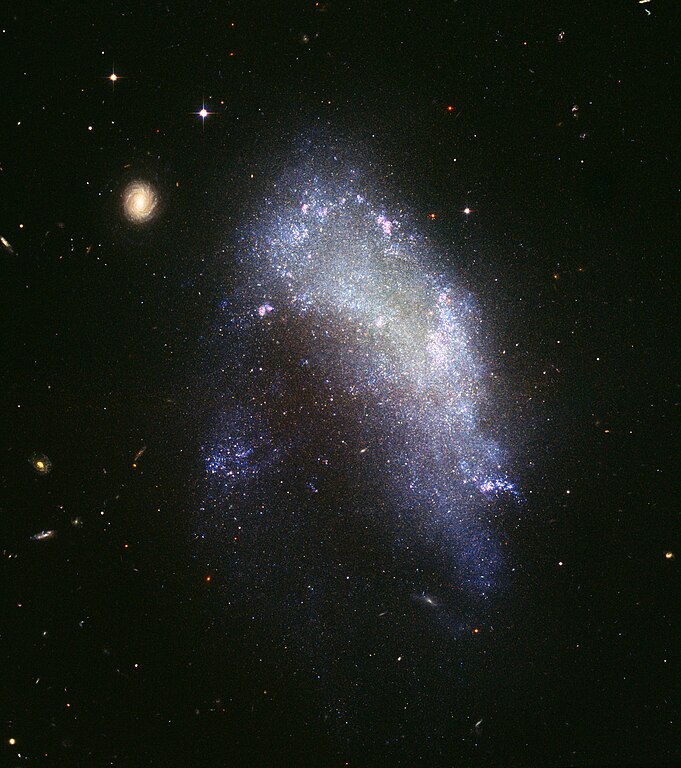
Caption: Irregular galaxy NGC 1427A in constellation Eridanus. NGC 1427A is in the Fornax Cluster which lies primarily in constellation Fornax.
Features:
- NGC 1427A is at
15.9(1.5) Mpc = 51.9(5.0) Mly and has
redshift velocity
2028(1) km/s.
- NGC 1427A is an
irregular galaxy
of
de Vaucouleurs system type
IB(s)m.
- There has been and still is extensive
star formation
in NGC 1427A.
The current star formation is evidenced by opaque brown (sort of obvious) caused dense concentrations interstellar dust.
The interstellar dust permits the existence of the molecules which cools the interstellar medium (ISM) gas by radiating away heat energy as electromagnetic radiation (EMR) (principally in the infrared and radio) which lowers the gas pressure which allows runaway gravitational collapses which fragment into newly forming stars. The EMR output of the new stars is dominated by hot blue OB stars which provide ultraviolet light which ionizes the atomic hydrogen gas to create H II regions (dominated by ionized atomic hydrogen gas) which emit strongly the red Hα of hydrogen (following recombination to neutral atomic hydrogen gas) which gives the H II regions their pink glow.
The upshot of the foregoing is that NGC 1427A has a complex and pretty mixture of colors: brown, blue, pink.
- Original Caption: "The irregular galaxy NGC 1427A will NOT survive long as an identifiable galaxy, passing through the Fornax Cluster at nearly 600 km/s. It is, in fact, heading toward the center of the Fornax Cluster and will perhaps be disrupted and galaxy merge with the cD or giant elliptical galaxy NGC 1399 which is the central galaxy of the Fornax Cluster within 1 Gyr (see Wikipedia: NGC 1427A).
Galaxy clusters, like the Fornax Cluster, contain hundreds or even thousands of individual galaxies. Within the Fornax Cluster, there is a considerable amount of gas (probably close to primordial cosmic composition) lying between the galaxies. When the gas within NGC 1427A collides with the Fornax Cluster gas, it is compressed to the point that it starts to collapse under its own self-gravity. This leads to star formation (as shown by the colors brown, blue, and pink) The compression gives NGC 1427A an overall arrowhead shape that appears to point in the direction of the galaxy's high-velocity motion (which yours truly thinks is upward in the image). The tidal forces of nearby galaxies in the Fornax Cluster may also play a role in triggering star formation on such a massive scale." (Heavily edited.)
- Original Caption: "The irregular galaxy NGC 1427A will NOT survive long as an identifiable galaxy, passing through the Fornax Cluster at nearly 600 km/s. It is, in fact, heading toward the center of the Fornax Cluster and will perhaps be disrupted and galaxy merge with the cD or giant elliptical galaxy NGC 1399 which is the central galaxy of the Fornax Cluster within 1 Gyr (see Wikipedia: NGC 1427A).
Image link: Wikimedia Commons: File:Irregular galaxy NGC 1427A (captured by the Hubble Space Telescope).jpg.
Local file: local link: ngc_1427a_irr.html.
File: Galaxies file: ngc_1427a_irr.html.